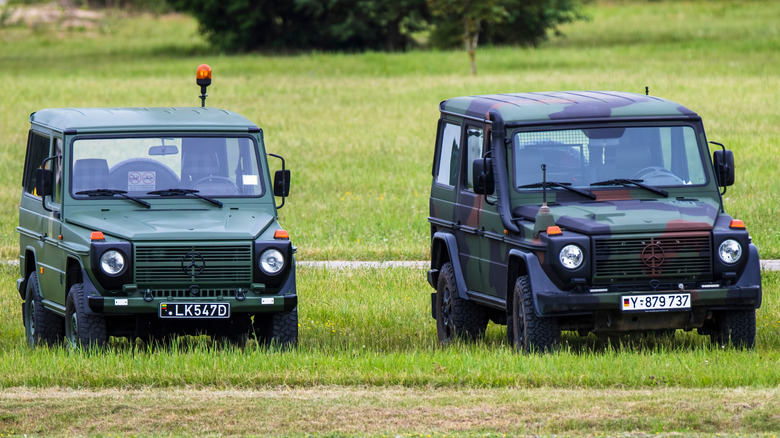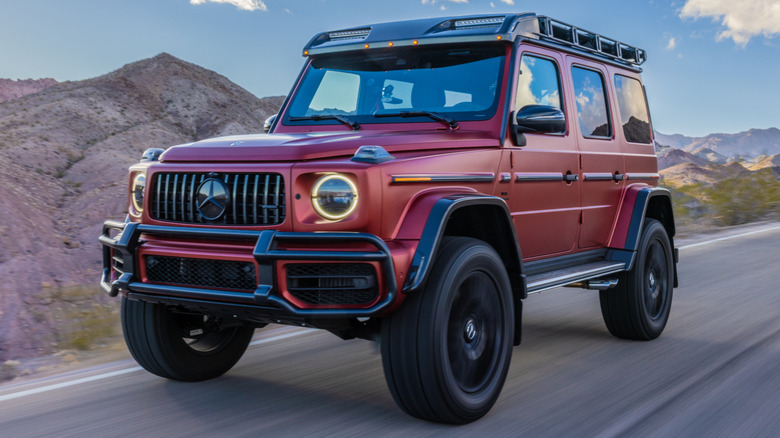What Does The 'G' Stand For On The Mercedes G-Wagon?
The Mercedes-Benz G-Wagen is one of the most popular SUV's in the world. Despite being nearly 50 years old, its performance, on or off-road capability, and durability have earned it a following since the SUV was released. Easily recognizable by its aggressive profile and boxy shape, this SUV is at home in both a city carpark or desolate desert fields.
Now in its fifth generation, the G-Wagen has seen success with each generation by improving its attributes. A product of Mercedes-Benz, the G-Wagen was initially conceived as a military off-roader. Its original name, G-Wagen — a shortened version of Geländewagen — was a German word that meant "cross-country" or "all-terrain vehicle."
Having fulfilled its original purpose in continuous use by the militaries of over 40 countries, the G-Wagen has since transformed itself to meet the contemporary demands of the market by providing specialized civilian versions. These road-worthy G-Wagens can be configured for a variety of purposes, including a six-wheeled version, alongside the mainstream G550 and G63 models.
The G-Wagen was created to conquer all types of terrain
The origins of the G-Wagen name can be traced back to the merger between the companies of Karl Benz and Dr. Gottlieb Daimler in 1926, resulting in Daimler-Benz. This new company soon produced the 170 series of automobiles, and later followed this up with the G1 — a stronger and more rugged platform that could be considered an ancestor of the modern SUV. This new model could be used in off-road or rough terrain, and because of its prototype status, it was given the "G" designation to signify its purpose: Geländewagen, an automobile that can go cross-country, on any terrain.
Throughout the 1930s to the 1940s, additional development was made on the G1, which later spawned several iterations; each having the letter "G" in its model designation — with the last being the G5, which production ended in 1941. After three decades, there was a renewed commercial interest in a vehicle that would be tough enough for military use, but could be offered to consumers. By 1973, the company Steyr-Daimler-Puch from Austria responded by designing a smaller, faster, and more nimble machine that was first called the H2. Ultimately, the old designation to convey a sturdy and powerful machine was again used, thus reviving the Geländewagen model name.
From those early versions made by Steyr-Daimler-Puch, to the production model W460 that rolled out of its Graz, Austria factory in 1979, the first generation G-Wagen was in production for 11 years until 1991. The W461 then replaced that first-gen G-Wagen in 1992. The second-generation lasted until 2022, had the most number of upgrades, and became the starting point of the modern G-Wagen as we know it today.
G-class is in session
At nearly $150,000 for the base model, the G-Wagen is a coveted model despite its expensive price tag, and the demand for the car remains strong. Nearly 11,000 units that were sold in the United States alone during the year 2024. Notwithstanding its age, even older generation G-Wagens have remained sought-after vehicles, and the used car market values have held up well.
Mercedes-Benz has stuck by its design and continues to build on it by integrating the latest technological and engineering advancements for each successive model of the G-Wagen. Each new G-Wagen has become bigger, more comfortable, and more powerful than its predecessors, and now comes equipped with standard features that excel beyond its originally spartan, military-oriented origins.
Despite this, at its core, the hardy and resilient foundation the G-Wagen was built upon remains intact. Mercedes-Benz G-Wagens, despite its now urban habitat, can still be taken off-road, climb hills, and wade through inches of flood water with ease, proving that the G-Wagen can still live up to its name as an all-terrain vehicle.


